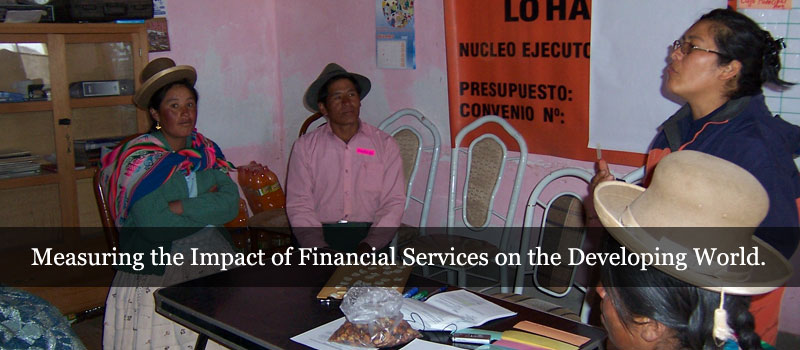Rethinking Client "Graduation"
An oft-discussed challenge for microfinance institutions, or MFIs, is that their best, most reliable clients will become so successful that they leave the original MFI to seek larger loans with commercial competitors—in a word, "graduating."
But a study conducted by Microfinance Opportunities, or MFO, found that clients of an MFI in Peru often retained the smaller loans, even as they sought bigger loans with competitors, compelled mostly by social capital and habit.
Understanding these retention factors will help MFIs reinforce them, which may inspire even more of the "good payers" to stick with their original MFI, even as they diversify their loan sources.
MFO's study, launched in November 2008, examined the use of the Premium loan, an innovative credit product offered by Pro Mujer Peru, or PMP. The Peru branch of an international, nongovernmental microfinance organization, PMP provides financial services as well as a health care net- work and education programs to low-income women entrepreneurs.
Like PMP's Regular loan product, the Premium is a group loan, but it is the organization's largest loan ever offered, with a longer term, less frequent payments, and lower interest rate. The loan is targeted at (and limited to) PMP's longer-term, more successful microentrepreneur borrowers—a bigger loan to meet the needs of bigger borrowers.
A Move to Retain the "Good Clients"
PMP's Premium loan is part of a trend among MFIs to offer new loan products for clients whose growing business needs can no longer be satisfied by the terms of conventional group loan products (cf. Nelson, et al., 1996). Underlying this trend is the potentiality that significant numbers of clients will leave their original MFIs behind to seek larger loans with commercial competitors—in a word, "graduate" to another institution. The Premium is designed to raise the credit ceiling at the original MFI and retain some portion of these "good clients," who tend to be more profitable to serve and thus beneficial to the MFI's portfolio.
A Closer Look at Use Patterns
Overwhelmingly, our investigation found that the Premium loan was just one part of the broad credit and cash-management strategies for these borrowers. On average, Premium clients had taken out five or six separate loans over the past year from a variety of sources. In other words, many clients continued to take PMP's other (smaller) loans in addition to the Premium, even though the Premium was ostensibly meant to replace those. They also took out a multitude of overlapping loans from other MFIs, banks, and non-bank commercial lenders. In total, two-thirds had taken a loan from a PMP competitor in the past year.
Some key figures tell the story: Premium loans used by clients in the past year comprised, on average, less than one-third of their total credit port- folio. Nearly 40 percent of the credit overall came from sources other than PMP. Perhaps most striking of all, a significant subpopulation had loans with commercial competitors that dwarfed all of their PMP loans in scale, up to 10 times larger—yet they retained the smaller PMP loans.
The most common stated reason for sticking with PMP? The social capital of clients' loan groups (cf. Mosley and Verschoor, 2005; Woolcock, 1998), which they missed with larger loans, as these tended to be individual loans. Clients generally explained social capital in terms of friendships and mutual support, personal and professional, developed within their loan groups. It should be noted that PMP was one of the first microfinance institutions to set up shop in southern Peru and has built a solid reputation for serving low-income clients with both credit and education programs. For clients, this has meant an abundance of time and a venerated space for the social capital relationships to grow and flourish. Clients second most common stated reason for sticking with PMP: habit. They had been with PMP for many years and had no intention of stopping now. Again, we note that PMP is one of the oldest players on southern Peru's microfinance landscape, and habits become more ingrained over time.
Reconsidering "Graduation"
Many MFIs have assumed that clients with large capital needs and access to much larger loans with competitors will pursue those larger loans while dropping the smaller ones at the original institution. This loan was PMP's attempt to counter that perceived trend by segment- ing their market and holding on to these successful and experienced clients.
Our study complicates "graduation" and countermeasures like the Premium loan because many of the best clients in fact "graduated" in the conventional sense (i.e. became eligible for larger loans with competitors, and successfully pursued them), but they retained the smaller loans with PMP and other lenders. For this group, it was not a question of small group loan or larger individual loan. Many wanted a mix— group loans and individual loans—and they achieved this mix, reaping the perceived value of each.
Ultimately, these findings suggest that a growing loan to meet the growing needs of prosperous clients may be missing the point. The drivers of client decision-making may be intangible factors, like social capital. MFIs that understand and recognize these subtleties may be best positioned to retain the "good clients."
Finally, the study raises other issues that might be taken up in future studies, such as whether poorer, unbanked clients are denied access to PMP's credit when better-off clients continue to snap up the Regular loans along with their Premium loans.




